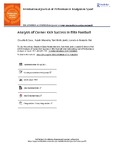Analysis of Corner Kick Success in Elite Football

Use este enlace para citar
http://hdl.handle.net/2183/36164
A non ser que se indique outra cousa, a licenza do ítem descríbese como Atribución-NoComercial-SinDerivadas 4.0 Internacional
Coleccións
- Investigación (CCDEF) [297]
Metadatos
Mostrar o rexistro completo do ítemTítulo
Analysis of Corner Kick Success in Elite FootballAutor(es)
Data
2015Cita bibliográfica
Casal, C. A., Maneiro, R., Ardá, T., Losada, J. L., & Rial, A. (2015). Analysis of corner kick success in elite football. International Journal of Performance Analysis in Sport, 15(2), 430-451.
Resumo
[Abstract]: This study analyzes corner kicks in elite football to determine their efficacy, identify shared characteristics and associated variables, and propose a model for predicting successful outcomes. In total, 1139 kicks taken in 124 matches in the 2010 FIFA World Cup (64 matches), UEFA Euro 2012 (31 matches), and the UEFA Champions League 2010-2011 (29 matches) were studied by univariate, bivariate, and multivariate analysis. Just 2.2% of the corners ended in goal, but this goal was responsible for the team winning or drawing the match on 76% of occasions. In general, kicks are delivered through the air to the near post, with 1 or 2 intervening attackers; the attack is organized statically and the defense is a combination of zone and man-to-man. The following variables were significantly associated with corner kicks resulting in a goal: time (p=0.04), number of intervening attackers (p=0.001), and offensive organization (p=0.02). The likelihood of a shot on goal or shot could be increased with the intervention of 3 or 4 attackers, a dynamic attack, and indirect delivery of the ball to the far post. This information could be of great interest for football professionals interested in improving corner kick performance.
Palabras chave
Football
Corner kick
Observational methodology
Performance analysis
Corner kick
Observational methodology
Performance analysis
Versión do editor
Dereitos
Atribución-NoComercial-SinDerivadas 4.0 Internacional
ISSN
2474-8668






